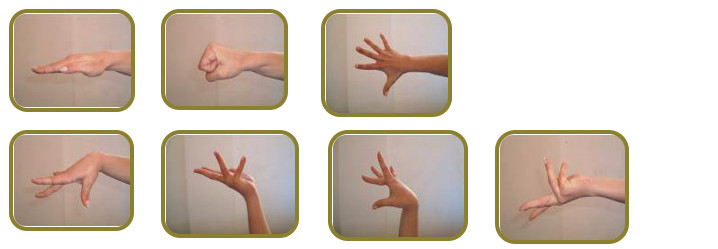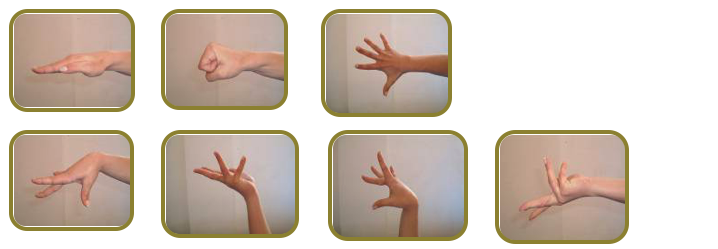In the Aerobic Content, we evaluate the Aerobic Movement Patterns (AMP) throughout the routine, with adequate intensity. The series of AMP are the foundation (bases) of Aerobic Gymnastics routines.
The quality (perfect technique) of the AMP is very important in order to be recognizable as a complex AMP sequence.
AMP must include variations of steps with arm movements, utilizing basic steps to produce complex combinations with a high level of body coordination and must be recognizable as continuous movement patterns.
AMP Sequence means a complete 8-count of movements with aerobic movement patterns performed in a musical phrase (from the 1st beat to the 8th beat) in order to stay with the music. If the AMP is performed for less than 8 counts, it will not be recognized as an AMP sequence, and considered as linking movements.
The AMP sequences should provide the adequate intensity for the aerobic gymnastics routines.
CRITERIA:
1.1. Amount of AMP
1.2. Complexity / Variety
The quality (perfect technique) of the AMP is very important in order to be recognizable as a complex AMP sequence.
AMP must include variations of steps with arm movements, utilizing basic steps to produce complex combinations with a high level of body coordination and must be recognizable as continuous movement patterns.
AMP Sequence means a complete 8-count of movements with aerobic movement patterns performed in a musical phrase (from the 1st beat to the 8th beat) in order to stay with the music. If the AMP is performed for less than 8 counts, it will not be recognized as an AMP sequence, and considered as linking movements.
The AMP sequences should provide the adequate intensity for the aerobic gymnastics routines.
CRITERIA:
1.1. Amount of AMP
1.2. Complexity / Variety
2.1. Amount AMP :
Throughout the routine, AMP Sequences with adequate intensity must be performed. This means, other than Difficulty Elements, Transitions/Linking, Lifts and Partnerships (physical interaction / collaborations), the routine must show continuous AMP Sequences.
The routine should provide a sufficient amount of complete AMP sequence sets. The number of AMP sequences required for all categories is 8 which can be performed in 1, 2, 3, or more consecutive units (sets).
The routine should provide a sufficient amount of complete AMP sequence sets. The number of AMP sequences required for all categories is 8 which can be performed in 1, 2, 3, or more consecutive units (sets).
2.2. Complexity / Variety:
AMP is the base of the aerobic gymnastics and main (principal) characteristic (Sports Specific).
The AMP Sequences are complex when both, legs and arms, are combined together with a high level of body coordination.
The specific technique of the basic steps is described in the Appendix II. The leg movements must show the correct technique (rebound) of Aerobic Basic Steps.
The arm movements for aerobic gymnastics also has specific technique, therefore the gymnasts must perform them with quality. The arm movements must show precision and fluency, with a clear trajectory from one position to another, showing the capacity to accelerate and decelerate the arm movement, with appropriate carriage of the head, the shoulders and the upper body.
Complex/variety AMP sequences can be achieved by:
- Involving more body parts (head, shoulders, etc…)
- Using different joint actions / planes / range of motion / lever length
- Using symmetric / asymmetric moves
- Using different rhythm
- Using both arms simultaneously
- Speed of motion
- Orientation changing
- Formation changing
- Travelling with AMP sequences
Throughout the routine, AMP Sequences must show variety without repetition of the same step/arm movements in the same 8 counts and the same or similar type of AMP Sequences during the routine. All basic steps must be used throughout the routine.
In order to achieve variety inside the AMP sequence, it is highly recommended to show in every 8 counts of AMP at least 3 different basics steps, without no more than 2 repetitions of the same basic step in the same 8 counts.
By showing variety of movements during the performing of every 8 counts of AMP, will also increase the level of complexity.
Examples of variations of 7 basic steps (also see execution descriptions in Appendix II).
Examples of variations for arm movements
Arm movements can be in different ranges of motion some of them can be more “delicate” as long as they have a meaning with the idea of the choreography, with the style and the category of the competitor.
The abuse of finger movements is not keeping with the direction of aerobic gymnastics discipline.
The AMP Sequences are complex when both, legs and arms, are combined together with a high level of body coordination.
The specific technique of the basic steps is described in the Appendix II. The leg movements must show the correct technique (rebound) of Aerobic Basic Steps.
The arm movements for aerobic gymnastics also has specific technique, therefore the gymnasts must perform them with quality. The arm movements must show precision and fluency, with a clear trajectory from one position to another, showing the capacity to accelerate and decelerate the arm movement, with appropriate carriage of the head, the shoulders and the upper body.
Complex/variety AMP sequences can be achieved by:
- Involving more body parts (head, shoulders, etc…)
- Using different joint actions / planes / range of motion / lever length
- Using symmetric / asymmetric moves
- Using different rhythm
- Using both arms simultaneously
- Speed of motion
- Orientation changing
- Formation changing
- Travelling with AMP sequences
Throughout the routine, AMP Sequences must show variety without repetition of the same step/arm movements in the same 8 counts and the same or similar type of AMP Sequences during the routine. All basic steps must be used throughout the routine.
In order to achieve variety inside the AMP sequence, it is highly recommended to show in every 8 counts of AMP at least 3 different basics steps, without no more than 2 repetitions of the same basic step in the same 8 counts.
By showing variety of movements during the performing of every 8 counts of AMP, will also increase the level of complexity.
Examples of variations of 7 basic steps (also see execution descriptions in Appendix II).
- March: angle, height, speed, rhythm change, or directions. (i.e. V-step, turn-step, two-steps, box-step)
- Jog: angle, speed, rhythm change, and directions
- Knee lift: planes, angle, speed, rhythm change, in High or Low Impact
- Kick: planes, height, speed, rhythm change, in High or Low Impact and directions. (i.e. middle kick, high kick, and vertical kick)
- Jumping Jack: angle at hips and knees speed, rhythm change, in High or Low Impact (squat)
- Lunge: planes, angle, speed, rhythm change, in High or Low Impact
- Skip: planes, angle and directions, speed, rhythm change, in High or Low Impact.
Examples of variations for arm movements
- Use of symmetrical and asymmetrical moves
- Use of different levels (short, medium, large)
- Use of linear and circular movements
- Use of different rhythm
- Use of different planes
- Use of different actions (flexion, extension, abduction, adduction, pronation, supination, etc.)
- Use of different hand positions (palm open, palm closed, fist….).
Arm movements can be in different ranges of motion some of them can be more “delicate” as long as they have a meaning with the idea of the choreography, with the style and the category of the competitor.
The abuse of finger movements is not keeping with the direction of aerobic gymnastics discipline.
EXAMPLES HANDS ACTIONS

INADEQUATE FINGER ACTIONS (NOT TO BE ABUSED)

SUMMARY
2.1. Amount of AMP:
DEVIATION FROM EXCELLENT (examples)
- The routines show less than 8 units or sets of complete AMP sequences.
2.2. Complexity / Variety:
o Use of the coordination criteria
o Perfect technique (quality)
o Use of the variety criteria
- Quantity of AMP sequences
DEVIATION FROM EXCELLENT (examples)
- The routines show less than 8 units or sets of complete AMP sequences.
2.2. Complexity / Variety:
o Use of the coordination criteria
o Perfect technique (quality)
o Use of the variety criteria
DEVIATION FROM EXCELLENT (examples)
· Low level of body coordination
· Excessive use of jogging / chasse actions
· Excessive use of super high impact movements
· Missing basic steps
· No combination of arm movements and leg movements
· Arm movements performed in double beats only
· Complex Arm movements but simple step combinations or vice versa
· No precise/clear shape of arm movements
· Lack of different arms actions
· Repetitive arm/leg movements
· Arm movements in small range of motion only
· Fast, frequent arm movements only
· Excessive use of jogging / chasse actions
· Excessive use of super high impact movements
· Missing basic steps
· No combination of arm movements and leg movements
· Arm movements performed in double beats only
· Complex Arm movements but simple step combinations or vice versa
· No precise/clear shape of arm movements
· Lack of different arms actions
· Repetitive arm/leg movements
· Arm movements in small range of motion only
· Fast, frequent arm movements only
SHORTHAND FOR AMP CONTENT
Every AMP sequences will be written with symbol A
If the AMP sequence meets the criteria mentioned above will be written A+
If the AMP sequence does NOT meets the criteria mentioned above will be written A-
If the AMP sequence meets the criteria mentioned above will be written A+
If the AMP sequence does NOT meets the criteria mentioned above will be written A-
SCALE FOR AEROBIC CONTENT
| Excellent 2.0 pt | A+ A+ A+ A+ A+ A+ A+ A+ (8 AMP+) |
| Very Good 1.9 pt | A+ A+ A+ A+ A+ A+ A+ A (7 AMP+) |
| Very Good 1.8 pt | A+ A+ A+ A+ A+ A+A A (6 AMP+) |
| Good 1.7 pt | A+ A+ A+ A+ A+ A A A (5 AMP+) |
| Good 1.6 pt | A+ A+ A+ A+ A A A A (4 AMP+) |
| Satisfactory 1.5 pt | A+ A+ A+ A A A A A (3 AMP+) |
| Satisfactory 1.4 pt | A+ A+ A A A A A A (2 AMP+) |
| Poor 1.3 pt | A+ A A A A A A A (1 AMP+) |
| Poor 1.2 pt | A+ A A A A A A A (1 AMP+) |
| Unacceptable 1.1 pt | A- A A A A A A A (1 AMP-) |
| Unacceptable 1.0 pt | A- A- A A A A A A (2 AMP- OR MORE) |
The AMP sequence will receive A+ when it will be performed with quality and correct technique including at least 3 criteria of the complexity and variety (i.e. 3 basic steps, traveling with orientation change and asymetric arms)
If less than 8 AMP sequences are performed, the score will be decreased 0.1 for each AMP sequence missed.
Example: 6 AMP are performed, all 6 AMP are A+, the score will be 1.6 (1.8 for 6 A+ minus 0.2 for 2 AMP sequences missed).
For every A- the score will be decreased 0.1 from the scale.
Example: 8 AMP sequences performed, A+ A+ A+ A+ A+ A+ A A-
The score in this case will be 1.7 (1.8 for 6 A+, minus 0.1 for 1 A-)







